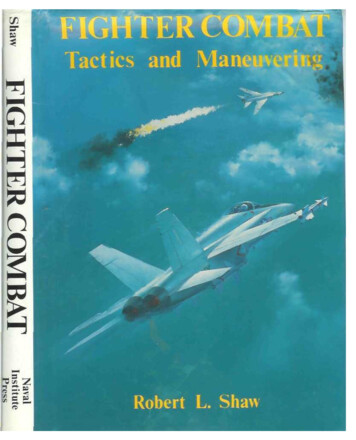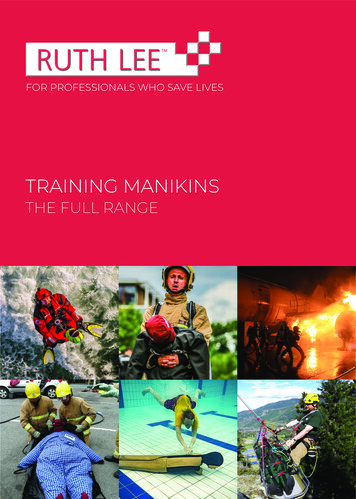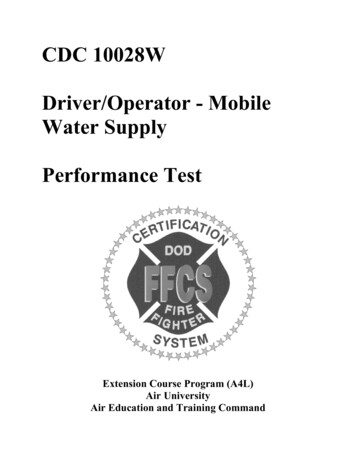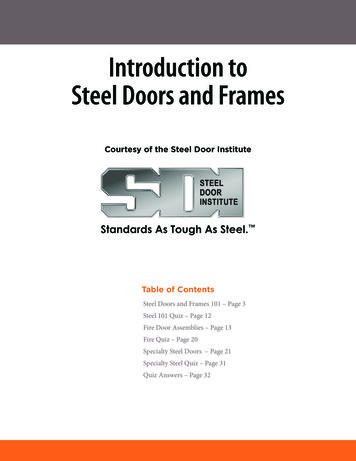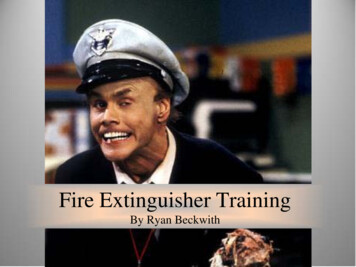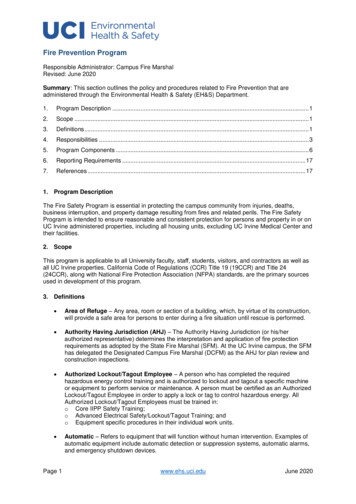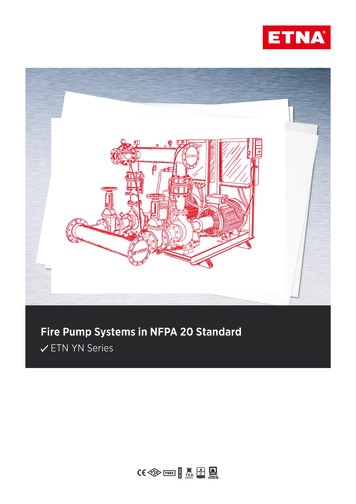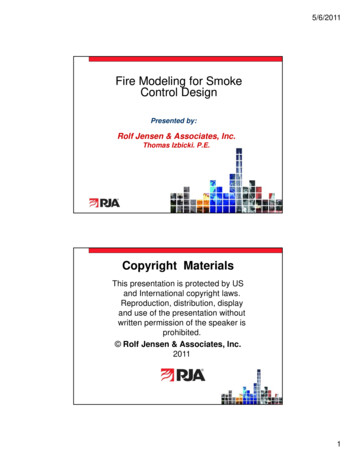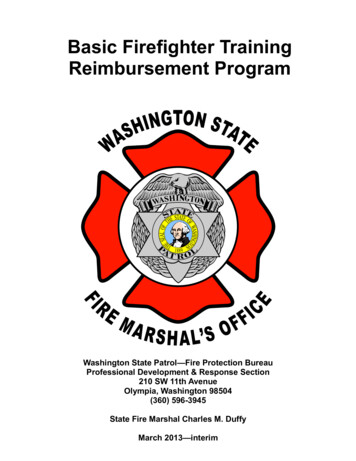
Transcription
Basic Firefighter TrainingReimbursement ProgramWashington State Patrol—Fire Protection BureauProfessional Development & Response Section210 SW 11th AvenueOlympia, Washington 98504(360) 596-3945State Fire Marshal Charles M. DuffyMarch 2013—interim
BASIC FIREFIGHTER TRAINING REIMBURSEMENT PROGRAM – INTERIM GUIDEMARCH 2013The Basic Firefighter Training Reimbursement Program manual iscurrently under review.The intent of the State Fire Marshal’s Office is to revise the program andmaterials following the agency’s adoption of the 2013 edition of theNational Fire Protection Association (NFPA) Firefighter 1 & 2Professional Qualification Standard (NFPA 1001). The anticipatedadoption date of NFPA 1001 is January of 2014.This manual and the current reimbursement contract application may beused until the publication of the Sixth Edition of the Manual.For questions please contact the Professional Development & ResponseSection at (360) 596-3945 or email basicff1@wsp.wa.gov .
THE BASIC FIRE FIGHTER TRAINING PROGRAMOffice of the State Fire Marshalwww.basicff1@wsp.wa.govFIFTH EDITION: May, 2005THE BASIC FIRE FIGHTERTRAINING PROGRAMFifth Edition: May, 2005ContentsPreface, Purpose, ObjectivesBasic Fire Fighter Training ProgramFire Fighter Training Reimbursement ScheduleFire Fighter Training by StandardsReporting and RecordkeepingInstructor Professional Development12-456-2020-2122Volunteer Recruit Schools23-26Training Resources27-28Community and Technical College Resources29Important DefinitionsDefinitions I-IIIApplicationsApplication i-ix
THE BASIC FIRE FIGHTER TRAINING PROGRAMOffice of the State Fire Marshalwww.basicff1@wsp.wa.govFIFTH EDITION: May, 2005PREFACEThis guidebook provides fire departments and districts with direction when providing the Officeof the State Fire Marshal funded fire fighter training to their members. This guide also providesguidance in the establishment of training requirements for fire fighters that need safety-specifictraining.This program was developed to provide fire fighter training in Washington State as a direct resultof legislation that was passed in the 1999 legislative session which provided funding for firefighter training at the local level. The following materials were developed with the guidance of aTechnical Advisory Group. The group included representatives of these organizations:Washington State Association of Fire ChiefsWashington Fire Commissioners’ AssociationWashington State Fire Fighters’ AssociationWashington State Council of Fire FightersWashington State Fire Training and Safety OfficersCommunity and Technical CollegesOffice of the State Fire MarshalFire Protection Policy BoardPURPOSEFire fighters need many levels of training to do their jobs in a safe and competent manner. Tominimize risks, the Basic Fire Fighter Training Program has been prepared to help the fireservice community address important safety training issues.The purpose of the Basic Fire Fighter Training Program is to provide training resources. Thisincludes a uniform plan of financial support for modular training options to ensure fire fightersacross the state meet a basic level of safe performance and professional development.OBJECTIVESEnsure that every fire department in the state of Washington has the ability and opportunity toprovide their fire fighters with basic fire fighter training that is affordable, accessible, achievableand based on community risk.
THE BASIC FIRE FIGHTER TRAINING PROGRAMOffice of the State Fire Marshalwww.basicff1@wsp.wa.govFIFTH EDITION: May, 2005The Basic Fire Fighter Training ProgramFifth Edition, May 2005Responding to the DirectiveRCW 43.43.934.1(f)“Develop and adopt a plan with a goal of providing fire fighter one and wildland training, asdefined by the (Fire Protection Policy) board, to all fire fighters in the state.”VisionTo ensure that every fire department in the state of Washington has the ability andopportunity to provide basic fire fighter training that is affordable, accessible, achievable andbased on community risk.Basic Fire Fighter ProgramThis program is designed to provide fire departments with financial support to facilitate andenable the training of fire fighters to minimum safety requirements. The program addresses thecurrently adopted NFPA 1001-2002 edition, NFPA 1403-1997 edition, NFPA 472-2001 editionand applicable sections of WAC 296-305.The Basic Fire Fighter Training Program is a “performance based” qualification system. In thissystem the primary criterion for qualification is individual performance in exercises or classroomactivities as observed by an evaluator qualified in that position, using approved standards anddocumented in a skill book.Program EligibilityParticipation is open to any city fire department or fire protection district in the State ofWashington.Available TrainingThe program allows participants to receive training, at the discretion of their fire department, asdescribed in the eleven modules.Program Set up ProcessFollowing established guidelines, each department determines the focus and schedules training.Subject to the module requirements and reimbursement provisions, there is no minimum numberof hours of training for any module. All training is to be performance based, however acomparable number of hours is assessed for each module so reimbursement falls within themaximum allowed 200 hours.Skill books may be used to ensure participants are aware of what is required for their jobs.Training documented in skill books or rosters may be signed by any person approved orauthorized by the employer’s representative (Fire Chief).Certain administrative support needed to startup and operate your basic fire fighter trainingprogram may be available. Contact the Office of the State Fire Marshal for details.
THE BASIC FIRE FIGHTER TRAINING PROGRAMOffice of the State Fire Marshalwww.basicff1@wsp.wa.govFIFTH EDITION: May, 2005To get startedUsing the form available at www.wsp.wa.gov\fire\basicff1.htm, download the application andinstructions and complete Part One.Applications must be submitted two weeks prior to the beginning of the training programstart date specified on the application.Print, Sign, Date and Mail to:Basic Fire Fighter Training ProgramOffice of the State Fire MarshalP.O. Box 42600Olympia, WA 98504-2600Limited training time, travel restrictions and work day commitment issuesThe Basic Fire Fighter Training Program recognizes that many trainees have restrictions on thetime available to achieve program objectives. Individual agencies will be given assistance inlocating and scheduling the necessary resources to meet their scheduling needs.When at all possible, we encourage departments with common training times, dates, andlocations to consider county or inter-departmental schools.It may be possible to use a variety of training techniques e.g., on-line or non-print media in theplan of delivery.Program CostsThere may be some costs to your department for support materials. For example, to make thebest use of the state-provided supplemental instructor materials, each student must have access toa copy of IFSTA Essentials 4th edition. The NFPA Fire Fighter –I curriculum support packagesthat are available through the program reference both the IFSTA 3rd or 4th editions. But IFSTAEssentials are not provided in this program. Note however, there is no required curriculum thatmust be followed to reach the competencies set out in the Skill Books.How to receive reimbursementThis program will provide reimbursement for fire protection districts and city fire department ofthree dollars for every comp hour of fire fighter training in modules 0 through X up to 200 hours.While there is no limit or minimum number of registrants for any single department class orprogram, departments/ districts are strongly encouraged to combine their fire fighter trainingprograms.Approval SignatureSkill books, applications or rosters can be signed by any person approved or authorized by theemployer’s representative (Fire Chief).
THE BASIC FIRE FIGHTER TRAINING PROGRAMOffice of the State Fire Marshalwww.basicff1@wsp.wa.govFIFTH EDITION: May, 2005Washington State IFSAC certificationCertification is a voluntary process in Washington State and is not a requirement forreimbursement in this program.Details regarding certification are contained within the Certification Guideline, which isavailable through the Fire Standards, Accreditation and Certification program of the Office of theState Fire Marshal.Training through Community and Technical CollegesFire fighter training delivered to fire departments or districts through a Community or TechnicalCollege that covers the subjects identified in the Basic Fire Fighter Training Program skill booksis reimbursed using the schedule and limits set.General instructor requirementsInstructors must be authorized by the department’s fire chief. It is entirely at the discretion ofyour department as to how arrangements are made with outside instructors. Reimbursementsfrom the Basic Fire Fighter Training Program are made directly to departments without referenceas to how the funds will be disbursed.Regional training councils may work with departments that do not have the resources to start orcoordinate programs. This may include: Assistance in training program design Record keeping Community Risk Assessment Locating training resources Evaluating training
THE BASIC FIRE FIGHTER TRAINING PROGRAMOffice of the State Fire Marshalwww.basicff1@wsp.wa.govFIFTH EDITION: May, 2005FIRE FIGHTER TRAINING REIMBURSEMENT SCHEDULEThe program includes reimbursement for fire protection districts and city fire departments threedollars for every hour of basic fire fighter training as described herein. The Washington StatePatrol does not provide reimbursement for more than two hundred hours of fire fighter trainingfor each individual trained.Training is provided in eleven instructional modules. These modules are intended to provide firedepartments with training to meet basic safety and professional requirements. The trainingmodule titles and reimbursement limits are:Module 0Fire Fighting SafetyReimbursement equal to 40 comp hours per student.Module IFire Fighter FundamentalsReimbursement equal to 100 comp hours per student.Module IILive Fire TrainingReimbursement equal to 20 comp hours per student.Module IIIFire Fighter I CertificationReimbursement equal to 40 comp hours per student.Module IVLocal Needs Training.Reimbursement equal to 40 comp hours per student.Module VWildland Fire Fighter Type 2Reimbursement equal to 50 comp hours per student.Module VIOperations Level Hazardous Materials TrainingReimbursement equal to 30 comp hours per student.Module VII Fire Fighter IIReimbursement equal to 40 comp hours per student.Module VIII Basic CommandReimbursement equal to 150 comp hours per student.Module IXSkill MaintenanceReimbursement equal to 8 comp hours per student.Module XCertification TrainingReimbursement equal to 8 comp hours per student.
THE BASIC FIRE FIGHTER TRAINING PROGRAMOffice of the State Fire Marshalwww.basicff1@wsp.wa.govFIFTH EDITION: May, 2005TRAINING BY STANDARDSModule 0FIRE FIGHTING SAFETYTraining required by WAC 296-305 Safety Standards for Firefighters.a. Basic First Aid, FF-First Responder or EMTWAC 296-305-01515 (1)b. EVAPWAC 296-305-04505 (8)c. HazMat AwarenessWAC 296-305-05011, 296-824and WMD Awareness Leveld. Confined Space, Trench,WAC 296-305-01505 (3) (a) (vii)Asbestos Awareness levele. Incident Command (NWCG I-100 & 200)WAC 296-305-05001 (1)f. Health and WellnessWAC 296-305-01509-(7)Module IFIRE FIGHTER FUNDAMENTALSGENERAL REQUIREMENTS NFPA 10015-1.1Training to awareness level of NFPA 472, Standard for ProfessionalCompetence of Responders to Hazardous Materials Incidents meeting therequirements of WAC 296-62-31125-1.1.1 General knowledge requirementsA.Critical aspects of NFPA 1500 as apply to basic fire fightersB.Organization of the fire departmentC.Role of the fire fighter in the organizationD.The mission of the fire serviceThe fire department:E.Standard operating proceduresF.Rules and regulations as they pertain to basic fire fightersG.The role of other agencies as they relate to thefire departmentH.Member assistance program aspectsRopes and knots:I.Knot types and usageJ.Difference between life safety and utility ropeK.Reasons for placing rope out of serviceL.Types of knots to use for given tools, ropes, or situationsM.Hoisting methods for tools and equipmentN.Using rope to support response activities
THE BASIC FIRE FIGHTER TRAINING PROGRAMOffice of the State Fire Marshalwww.basicff1@wsp.wa.govFIFTH EDITION: May, 20055-1.1.2 General skill requirements: ability to:A.Don personal protective clothing within one minuteB.Doff personal protective clothing and prepare for reuseAbility to:C.Hoist tools and equipment using ropes and the correct knotD.Tie the following knots:BowlineClove hitchFigure of eight on a bightHalf hitchBecket or sheet bendSafety knotE.Locate information in departmental documents and standard orcode materials5-2FIRE DEPARTMENT COMMUNICATIONSInitiate Response to a Reported EmergencyKnowledgeA.Procedures for reporting emergenciesB.Department sops for taking and receiving alarmsC.Radio codes or proceduresInformation needs of dispatch centerD.Skills – Ability to:E.Operate fire department communications equipmentF.Relay informationG.Record information5-2.2Use of TelephoneKnowledgeA.Department procedures for answering nonemergency phone callsSkills – Ability to:B.Operate fire station telephone and intercom equipment5-2.15-2.3Transmit and Receive Radio MessagesKnowledgeA.Department radio procedures and etiquette for:Routine trafficEmergency trafficEmergency evacuation signalsSkills – Ability to:B.Operate radio equipmentC.Discriminate between routine and emergency traffic
THE BASIC FIRE FIGHTER TRAINING PROGRAMOffice of the State Fire Marshal5-3www.basicff1@wsp.wa.govFIFTH EDITION: May, 2005FIREGROUND OPERATIONS5-3.1SCBA Use During Emergency OperationsKnowledgeA.Conditions that require respiratory protectionB.Uses and limitations of SCBAC.Components of SCBAD.Donning procedures for SCBAE.Breathing techniquesF.Emergency procedures used with SCBAG.Physical requirements of the SCBA wearerSkills – Ability to:H.Control breathingI.Replace SCBA cylindersJ.Use SCBA to exit through restricted passagesK.Initiate and complete emergency procedures in event of SCBAfailure or air depletionL.Complete SCBA donning procedures5-3.2Respond on an Apparatus to an Emergency SceneKnowledgeA.Mounting and dismounting procedures for riding fire apparatusB.Hazards and ways to avoid associated with riding fire apparatusC.Prohibited practices while operating on or near a fire apparatusD.Types of personal protective equipment and means for usage*(This is equipment used while riding such as hearingprotection.)Skills – Ability to:E.Use each piece of provided safety equipmentDemonstrate the proper hand signal used when guidingapparatus.Note: Text in italics is not a mandatory Fire Fighter I Performance task. It is asuggested mean of meeting the desired objective5-3.3Operating in Established Work Areas at Emergency Scene(Traffic Control)Knowledge:A.Traffic HazardB.Electrical and Other Hazards Associated with the SceneC.Personal Protective Clothing and Traffic Warning EquipmentSkills-Ability to:D.Operate in High Traffic EnvironmentE.Wear Personal Protective ClothingF.Establish a Protective Work EnvironmentG.Demonstrate Traffic Control
THE BASIC FIRE FIGHTER TRAINING PROGRAMOffice of the State Fire Marshal5-3.3www.basicff1@wsp.wa.govFIFTH EDITION: May, 2005Operating in Established Work Areas at Emergency Scene(Downed Electrical Wire)Knowledge:A.Electrical HazardsB.Environmental and Other HazardsC.Personal Protective Clothing and Traffic Warning EquipmentSkills-Ability to:D.Establish Danger ZoneE.Wear Personal Protective ClothingF.Demonstrate Traffic ControlFIREGROUND OPERATIONS NFPA5-3.4Force Entry into a StructureKnowledgeA.Basic construction of typical doors, window, and walls withindepartment’s community or service areaB.Operation of doors, windows, and locksC.Dangers associated with forcing entry through doors, windows,and wallsSkills – Ability to:D.Transport (carry) hand and power toolsE.Operate hand and power toolsF.Force entry through doors, windows, and walls usingassorted methods and tools5-3.5Exit a Hazardous Area as a TeamKnowledgeA.Personnel accountability systemsB.Communications proceduresC.Emergency evacuation methodsD.What constitutes a safe havenE.Elements that create or indicate a hazardF.Emergency procedures for loss of air supplySkill – Ability to:G.Operate as a team member in vision-obscured conditionsH.Locate and follow a guidelineI.Conserve air supplyJ.Evaluate areas for hazardsK.Identify a safe haven
THE BASIC FIRE FIGHTER TRAINING PROGRAMOffice of the State Fire Marshalwww.basicff1@wsp.wa.govFIFTH EDITION: May, 20055-3.6Set up Ground LaddersKnowledgeA.Parts of a ladderB.Hazards associated with ladder placementC.What constitutes a stable foundation for ladder placementD.Ladder angles for various tasksE.Safety limits to the degree of angulationF.What constitutes a reliable structural component for topplacementSkill – Ability to:G.Carry, raise, extend ladders, and lock fliesH.Determine that a wall and roof will support ladderI.Judge extension ladder height requirementsJ.Place ladder to avoid obvious hazards5-3.9Conduct a Search and Rescue in a StructureKnowledgeA.Use of forcible entry tools during rescue operationsB.Ladder operations for rescueC.Psychological effect of operating in obscured conditions andways to manage themD.Methods to determine if area tenableE.Primary and secondary search techniquesF.Team member’s roles and goalsG.Methods to use and indicators of finding victimsH.Victim removal methods (including carries)I.Considerations related to respiratory protectionSkills – Ability to:J.Use SCBA to exit restricted passagesK.Set up and used different types ladders for various rescueoperationsL.Rescue fire fighter with functioning respiratory protectionM.Rescue fire fighter who’s SCBA is not functioningN.Rescue person who has no respiratory protectionO.Assess areas to determine tenabilityDemonstrate the removal of injured persons from an immediatehazard by the use of carries, drags, and stretchers.)Note: Text in italics is not a mandatory Fire Fighter I Performance task. It is asuggested mean of meeting the desired objective.
THE BASIC FIRE FIGHTER TRAINING PROGRAMOffice of the State Fire Marshal5-3.10www.basicff1@wsp.wa.govFIFTH EDITION: May, 2005Attack an Interior Structure Fire (Partial)KnowledgeA.Principle of fire streamsB.Nozzles (types, design, operation, flow capabilities)C.Precautions to be followed when advancing hose lines to a fireD.Observable results when fire stream properly appliedE.Fire caused dangerous building conditionsF.Principles of exposure protection.G.Potential long-term consequences of exposure to products ofcombustionH.Physical states of matter in which fuels are foundI.Common types of accidents or injuries ground and their causesJ.Application of each size and type of attack lineK.Role of backup team in fire attack situationsSkills – Ability to:L.Define and prevent water hammerM.Open, close, and adjust nozzle pattern and flowN.Apply water using direct, indirect and combination attacksO.Advance charged and uncharged lines (1 ½ - in. or larger):Up laddersUp and down interior stairwaysUp and down exterior stairwaysP.Extend hose linesQ.Replace burst hose sectionR.Operate charged hose lines (1 ½ - in. or larger) while secured to aground ladderS.Couple and uncouple various hose connectionsT.Carry hoseClimb the full length of each type of ground and aerial ladderavailable to the authority having jurisdiction and demonstrate:(a) Carrying fire fighting tools or equipment while ascendingand descending(b) Bringing an injured person down the ladders.Demonstrate carrying a 100 ft attack line 1 and 1/2 in. orlarger into a building, connecting it to a standpipe, andadvancing the line from the standpipe (this skill may bedescribed if building with standpipe is not present in thedepartment service area).Don a life safety harness that meets the requirements ofNFPA 1983, Standard on Fire Service Life Safety Rope,Harnesses, and Hardware.Demonstrate the use of nozzles, adapters, hose appliancesand tools on a pumper as required by Section 7-2 of NFPA1901
THE BASIC FIRE FIGHTER TRAINING PROGRAMOffice of the State Fire Marshalwww.basicff1@wsp.wa.govFIFTH EDITION: May, 20055-3.11Perform Horizontal Ventilation on a Structure (Partial)KnowledgeA.Principles, advantages, limitations, and effects of horizontalmechanical, and hydraulic ventilationsB.Safety consideration when entering a structureC.Prevention of a back draftD.Structural fire behaviorE.Products of combustion found in a structure fireF.Signs, causes, effects, and prevention of back draftsG.Relationship of oxygen concentration to life safety and firegrowthSkills – Ability to:H.Transport (carry) and operate ventilation tools and equipmentand laddersI.Use safe procedures for breaking window and door glass andremoving obstructions5-3.12 Perform Vertical Ventilation on a Structure (Partial)KnowledgeA.Methods of heat transferB.Principles of thermal layering within a structure fireDefine fireDefine the fire triangle and tetrahedronC.Techniques and safety precautions for venting:Flat roofs, Pitched roofs, BasementsD.Basic indicators of potential collapse or roof failureE.Effects of construction type and elapsed time under fireconditions on structural integrityF.The advantages and disadvantages of vertical andtrench/strip ventilationSkills – Ability to:E.Transport (carry) and operate ventilation tools and equipmentF.Hoist ventilation tools to roofG.Cut roofing and flooring materials to vent flat and pitched roofsand basementsH.Sound roof for integrityI.Clear an opening with hand toolsJ.Select, carry, deploy, and secure ground ladders for ventilationactivitiesK.Deploy roof ladders on pitched roofs from ground ladderL.Carry ventilation tools and equipment while ascending anddescending laddersDemonstrate the procedures of working from ground or aerial ladders with tools andappliances, with and without a safety harnessNote: Text in italics is not a mandatory Fire Fighter I Performance task. It is asuggested mean of meeting the desired objective.
THE BASIC FIRE FIGHTER TRAINING PROGRAMOffice of the State Fire Marshal5-3.13www.basicff1@wsp.wa.govFIFTH EDITION: May, 2005Overhaul a Fire SceneKnowledgeA.Types of attack lines and water application devices effective foroverhaulB.Water application methods for extinguishment that limit waterdamageC.Types of tools and methods used to expose hidden firesD.Dangers associated with overhaulE.Obvious signs of area of origin or signs of arsonF.Reasons for protection of fire sceneIdentify the purpose of overhaul.Recognize at least 4 indicators of hidden fires.Note: Text in italics is not a mandatory Fire Fighter I Performance task. It is asuggested mean of meeting the desired objective.Skills – Ability to:G.H.5-3.14Deploy and operate an attack lineRemove flooring, ceiling, wall components to expose voidspaces without compromising structural integrityI.Apply water for maximum effectivenessJ.Expose and extinguish hidden fires in walls, ceilings, andsubfloor spacesK.Recognize and preserve signs of arsonL.Evaluate for complete extinguishmentConserve Property as a Member of a TeamKnowledgeA.Purpose of property conservation and its value to the publicB.Methods used to protect propertyC.Types and uses for salvage coversD.Operations at properties protected with automatic sprinklersE.How to stop flow of water from an automatic sprinkler headF.Identification of main control valve of sprinkler systemG.Forcible entry issues related to salvageSkills – Ability to:H.Cluster furnitureI.Deploy covering materialsJ.Roll and fold salvage covers for reuseK.Construct water chutes and catch-allsL.Remove waterM.Cover building openings including doors, windows, flooropenings, and roof openingsN.Separate, remove, and relocate charred material to safe locationwhile protecting area of originO.Stop flow of water from sprinkler with wedges or stoppersP.Operate main control valve of sprinkler system
THE BASIC FIRE FIGHTER TRAINING PROGRAMOffice of the State Fire Marshalwww.basicff1@wsp.wa.govFIFTH EDITION: May, 20055-3.15Connect a Fire Department Pumper to a Water SupplyKnowledgeA.Loading and off-loading procedures for mobile water supplyapparatusB.Fire hydrant operationC.Suitable static water supply sourcesD.Procedures and protocol for connecting to various water sourcesSkills – Ability to:E.Hand lay a supply hoseF.Connect and place hard suction hose for draftingG.Deploy portable water tanks and equipment needed to transferwater between and draft from the tanks (if portable water tanksare not used in the department service area, this skill may bedescribed)H.Make hydrant-to-pumper hose connections for forward andreverse laysI.Connect supply hose to a hydrant and fully open and closehydrant5-3.16Extinguish Incipient Class A, B, and C Fires with Portable FireExtinguishersKnowledgeA.Classifications of fireB.Types and rating systems of fire extinguishersC.Risks of each class of fireD.Operating methods and limitations of each type of extinguishersSkills – Ability to:E.Operate portable fire extinguishersF.Approach fire with portable fire extinguishersG.Select an extinguisher based on size and type of fireH.Safely carry portable fire extinguishers5-3.17 Illuminate the Emergency SceneKnowledgeA.Safety principles and practicesB.Power supply capacity and limitationsC.Light deployment methodsSkills – Ability to:D.Operate department power supply and lighting equipmentE.Deploy cords and connectorsF.Reset ground-fault interrupter devicesG.Locate lights for best effect
THE BASIC FIRE FIGHTER TRAINING PROGRAMOffice of the State Fire Marshal5-5www.basicff1@wsp.wa.govFIFTH EDITION: May, 20055-3.18Turn off Building UtilitiesKnowledgeA.Properties, principles, and safety concerns for electricity, gas,and water systemsB.Utility disconnect methods and associated dangersC.Use of required safety equipmentSkills – Ability to:D.Identify utility control devicesE.Operate control valves or switches and assess for related hazards5-3.19Combat a Ground Cover FireKnowledgeA.Types of ground cover firesB.Parts of ground cover firesC.Methods to contain or suppress ground cover firesD.Safety principles and practicesSkills – Ability to:E.Determine exposure threats based on fire spread potentialF.Protect exposuresG.Construct a fire line or extinguish with hand toolsH.Maintain integrity of established fire linesI.Suppress ground cover fires using waterPREVENTION, PREPAREDNESS, AND MAINTENANCE5-5.1Perform a Fire Safety Survey in a Private DwellingKnowledgeA.Organizational policy and proceduresB.Common causes of fire and their preventionC.Importance of a fire safety surveyD.Public fire education programs importance to public relationsand communitySkills – Ability to:E.For survey in a private dwelling complete forms used, recognizehazards, and match findings to preapproved recommendations,and communicate findings to occupants or referred5-5.2Present Fire Safety InformationKnowledgeA.Parts of informational materials and how to use themB.Basic presentation skillsC.Department SOP for giving station toursSkills – Ability to:D.Document presentationsE.Use prepared materials
THE BASIC FIRE FIGHTER TRAINING PROGRAMOffice of the State Fire Marshalwww.basicff1@wsp.wa.govFIFTH EDITION: May, 20055-5.3CLEAN AND CHECKING EQUIPMENT (PARTIAL)KnowledgeA.Types of cleaning methods for Personal protective equipmentand SCBAB.Types of cleaning methods for various tools and equipmentC.Correct use of cleaning solventsD.Manufacturer’s and departmental guidelines for cleaning tools &equipmentSkills – Ability to:E.Select correct tools for cleaning useF.Follow guidelinesG.Record and report proceduresThe above standards address the following SCBAH.Select correct tools for cleaning useI.Follow guidelinesJ.Record and report proceduresThe above Standards address the followingForcible entry toolsRopesSalvage equipmentLaddersNozzles5-5.4Clean, Inspect, and Return Fire Hose to ServiceKnowledgeA.Departmental procedures for noting defective hose and removingfrom serviceB.Hose cleaning methodsC.Hose rollsD.Hose loadsSkills – Ability to:E.Clean different types of hoseF.Operate hose washing & drying equipment availableG.Mark defective hoseH.Replace coupling gasketsI.Roll hoseJ.Reload hose
THE BASIC FIRE FIGHTER TRAINING PROGRAMOffice of the State Fire Marshalwww.basicff1@wsp.wa.govFIFTH EDITION: May, 2005MODULE IILIVE FIRE TRAININGRequired Training, As Defined by the Employer, Before Live Structural Fire Training:WAC 296-305-05501, 05503:Safety practicesProtective equipmentFire HosesNozzlesFire StreamsLaddersRescueLive fire training conforming to NFPA 1403** Live fire training evolutions in structures requires that prior to their being permitted toparticipate in live fire training evolutions students must meet the performance objectives for firefighter of the following NFPA 1403 sections:5-3Safety5-5Fire BehaviorPortable ExtinguishersPersonal Protective Equipment5-11LaddersFire Hose, Appliances, & Streams5-16Overhaul5-17Water SupplyFIREGROUND OPERATIONS NFPA 1001-5-3Attack a Passenger Vehicle Fire5-3.7KnowledgeA.Principle of fire streams as relate to fighting auto firesB.Precautions to be followed when advancing hose lines towardauto firesC.Observable results of properly applied fire streamsD.Identifying alternative fuels and their hazardsE.Dangerous conditions created during auto fireF.Common types of accidents or injuries related to fighting autofire and how to avoidG.How to access locked passenger, trunk, and enginecompartmentsH.Methods of overhauling an auto fireSkills- Ability to:I.Identify fuel
210 SW 11th Avenue Olympia, Washington 98504 (360) 596-3945 . currently adopted NFPA 1001-2002 edition, NFPA 1403-1997 edition, NFPA 472-2001 edition and applicable sections of WAC 296-305. . Health and Wellness WAC 296-305-01509-(7) Module I . FIRE FIGHTER FUNDAMENTALS .
